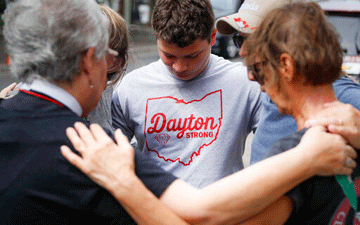
AP Photo - Dan Sewell
Yael Kidron is the director of Education Ethics at the Markkula Center for Applied Ethics. Views are her own. [1]
“The world is indeed full of peril, and in it there are many dark places; but still there is much that is fair, and though in all lands love is now mingled with grief, it grows perhaps the greater.”
― J.R.R. Tolkien, The Fellowship of the Ring
Mass shootings rattle our trust in our physical and social environments and leave us feeling vulnerable. While people cope differently with these events, there is a growing sense of collective trauma – shared concerns about the strength of the bonds which hold society together.
The public has a moral right to investigate measures of security, such as gun control laws, the preparedness of first responders, and preventive mental health services. But these concerns can be framed through a rhetoric of blame or using the lenses of the ethics of care. Ethical caring begins with discerning the needs of others and being our best selves when taking action to foster others’ well-being.
How reporters, policymakers, and other public figures discuss mass shootings can focus the public eye on unity instead of fractures in society, and it can drive actions of repair rather than moral panic. The following comment by a Virginia Tech student in the aftermath of the mass shooting that killed 33 students and faculty and injured 17 others in 2007 demonstrates how some types of framing (which may have started as well-intentioned critical examinations of public safety) can amplify rather than mitigate the trauma:[2]
We heard stories insulting our police force, attacking our university president, questioning our mental health professionals, and even words suggesting that our students should have done more. We heard that we should have been different, that we may have been to blame, and that our ignorance was blinding.
Negative news, or problem-focused stories, can contribute to audiences feeling helpless and hopeless, whereas constructive approaches to journalism can help the public understand the prospects for change.[3]
Equity and Resilience
Because collective trauma can be felt by some more than others, it is essential to understand the impact of the event. Both direct victims and other members of society that may vicariously experience trauma because of their history of victimization and loss are likely to need help. Vulnerable populations can feel victimized twice: first through the direct or indirect impact of the crime and a second time while navigating unequal access to medical, mental health, and welfare services. Vicarious traumatization can contribute to empathic over-arousal, which in turn may lead to fatigue, despondency, and desensitization—all of which act to the detriment of people’s health.[4]
Emphasizing community cohesion and social support in the aftermath of traumatic events can foster healing and restore people’s trust in the benevolence of their community. Under the unity narrative, media stories show how communities come together to care for all their members. These stories feature volunteers in schools as well as blood donations at local donation centers. They recognize funeral homes that forgo their fees, hospitals that waive medical costs, and hospital visits by FBI specialists who help the victims recover physically and emotionally.
In the era of citizen journalism, every person can contribute to a culture of caring and equity by choosing to share those stories that focus on unity and community support. Stories of kindness, fairness, and generosity are uplifting and can motivate us to exercise the same virtues in our lives. More importantly, through social networks, stories of kindness can maximize the reach of unity messages in all diverse parts of society and create a sustainable view of our shared ethical principles and humanity.
[1] Anita Varma, assistant director of Journalism & Media Ethics as well as Social Sector Ethics, provided input into this article.
[2] Piercy, F., Banker, J., Traylor, R., Krug, S., Castanos, C., Cole, E., … Goodwin, A. (2008). A Virginia Tech MFT ethics class reflects on the shootings at Virginia Tech. Journal of Marital and Family Therapy, 34(2), 210–226.
[3] Aitamurto, T., & Varma, A. (2018). The constructive role of journalism: Contentious metadiscourse on constructive journalism and solutions journalism. Journalism Practice, 12(6), 695-713.
[4] Davis, M. H. (1996). Empathy: A social psychological approach. Boulder, Colo: WestviewPress. Hoffman, M. L. (2000). Empathy and moral development: Implications for caring and justice. Cambridge, U.K: Cambridge University Press.
